The ASUS Maximus VIII Impact Z170 ROG Mini-ITX Motherboard Review
by Ian Cutress on December 29, 2015 9:00 AM ESTSystem Performance
Not all motherboards are created equal. On the face of it, they should all perform the same and differ only in the functionality they provide - however this is not the case. The obvious pointers are power consumption, but also the ability for the manufacturer to optimize USB speed, audio quality (based on audio codec), POST time and latency. This can come down to manufacturing process and prowess, so these are tested.
Power Consumption
Power consumption was tested on the system while in a single MSI GTX 770 Lightning GPU configuration with a wall meter connected to the OCZ 1250W power supply. This power supply is Gold rated, and as I am in the UK on a 230-240 V supply, leads to ~75% efficiency > 50W, and 90%+ efficiency at 250W, suitable for both idle and multi-GPU loading. This method of power reading allows us to compare the power management of the UEFI and the board to supply components with power under load, and includes typical PSU losses due to efficiency. These are the real world values that consumers may expect from a typical system (minus the monitor) using this motherboard.
While this method for power measurement may not be ideal, and you feel these numbers are not representative due to the high wattage power supply being used (we use the same PSU to remain consistent over a series of reviews, and the fact that some boards on our test bed get tested with three or four high powered GPUs), the important point to take away is the relationship between the numbers. These boards are all under the same conditions, and thus the differences between them should be easy to spot.
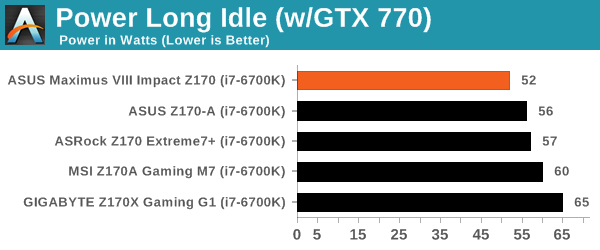
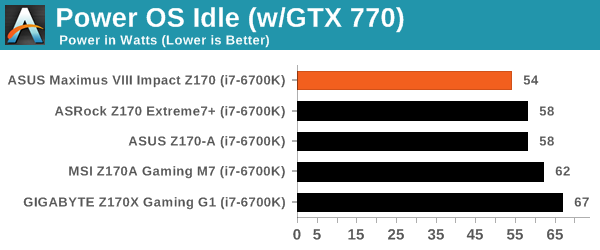
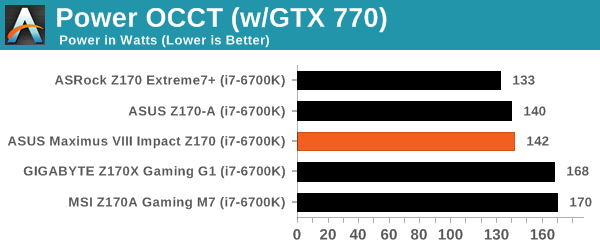
The Impact uses MultiCore Turbo, which typically increases the voltage at load to ensure a consistent top multiplier no matter what the loading is. The result of this increased performance is typically increased power consumption, and we’ve seen motherboards cause the i7-6700K CPU to consume 76W (from idle to OCCT load) up to 110W. With the Impact, perhaps due to its size, makes that delta only 90W, which isn’t as good as the non-MCT motherboards, but it currently the best MCT motherboard for power draw we’ve tested.
Non UEFI POST Time
Different motherboards have different POST sequences before an operating system is initialized. A lot of this is dependent on the board itself, and POST boot time is determined by the controllers on board (and the sequence of how those extras are organized). As part of our testing, we look at the POST Boot Time using a stopwatch. This is the time from pressing the ON button on the computer to when Windows 7 starts loading. (We discount Windows loading as it is highly variable given Windows specific features.)
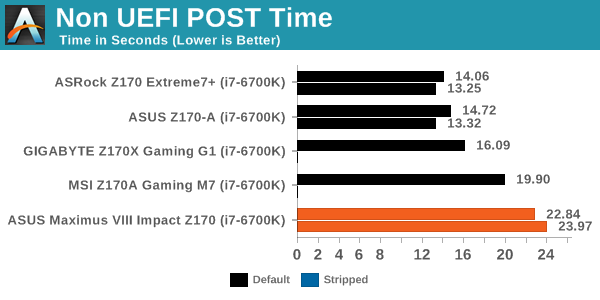
Anything over 20 seconds for a mainstream motherboard is usually seen as odd, which is why question marks come over the Impact sitting at 22 seconds when the Maximus VIII Extreme (which is being tested) only needs 16.50 seconds.
Rightmark Audio Analyzer 6.2.5
Rightmark:AA indicates how well the sound system is built and isolated from electrical interference (either internally or externally). For this test we connect the Line Out to the Line In using a short six inch 3.5mm to 3.5mm high-quality jack, turn the OS speaker volume to 100%, and run the Rightmark default test suite at 192 kHz, 24-bit. The OS is tuned to 192 kHz/24-bit input and output, and the Line-In volume is adjusted until we have the best RMAA value in the mini-pretest. We look specifically at the Dynamic Range of the audio codec used on board, as well as the Total Harmonic Distortion + Noise.
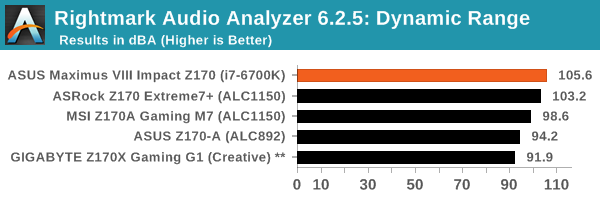
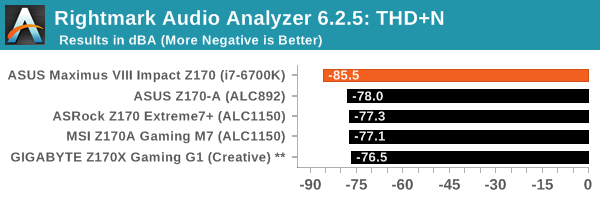
ASUS’ audio results in our test keep hitting high notes (pun intended), and the Impact is no different with a good SNR but also great distortion numbers.
USB Backup
For this benchmark, we transfer a set size of files from the SSD to the USB drive using DiskBench, which monitors the time taken to transfer. The files transferred are a 1.52 GB set of 2867 files across 320 folders – 95% of these files are small typical website files, and the rest (90% of the size) are small 30 second HD videos. In an update to pre-Z87 testing, we also run MaxCPU to load up one of the threads during the test which improves general performance up to 15% by causing all the internal pathways to run at full speed.
Due to the introduction of USB 3.1, as of June 2015 we are adjusting our test to use a dual mSATA USB 3.1 Type-C device which should be capable of saturating both USB 3.0 and USB 3.1 connections. We still use the same data set as before, but now use the new device. Results are shown as seconds taken to complete the data transfer.
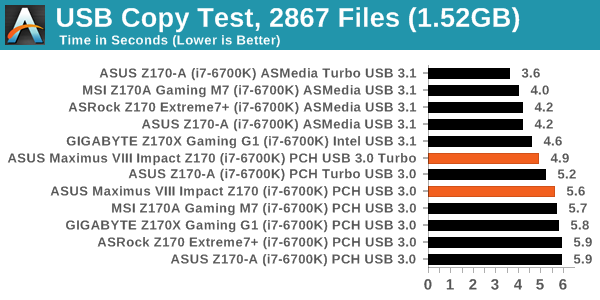
The USB 3.0 performance for the Impact was good to take top spot in our non-Turbo testing, but we had issues on the Impact testing the Alpine Ridge controller in USB 3.1 mode, as well as either mode using the Boost software. The test would end quickly, but say all the data is transferred and yet the drive is still working, showing that reporting the complete transfer is happening before the data is committed. Thus always make sure the drive is finished before removing! It also means we can’t run our tests properly.
DPC Latency
Deferred Procedure Call latency is a way in which Windows handles interrupt servicing. In order to wait for a processor to acknowledge the request, the system will queue all interrupt requests by priority. Critical interrupts will be handled as soon as possible, whereas lesser priority requests such as audio will be further down the line. If the audio device requires data, it will have to wait until the request is processed before the buffer is filled.
If the device drivers of higher priority components in a system are poorly implemented, this can cause delays in request scheduling and process time. This can lead to an empty audio buffer and characteristic audible pauses, pops and clicks. The DPC latency checker measures how much time is taken processing DPCs from driver invocation. The lower the value will result in better audio transfer at smaller buffer sizes. Results are measured in microseconds.

ASUS has been on a recent march towards low DPC numbers, and the Impact scores under 50 microseconds, making it one of our best ever results. The victory is short lived however, as we’re currently testing the Maximus VIII Extreme, and that scored under 25.










42 Comments
View All Comments
A5 - Tuesday, December 29, 2015 - link
I'd rather have 4 more USB ports than the wireless or debug LEDs, but this product isn't really for me to begin with.Flunk - Tuesday, December 29, 2015 - link
I agree with you, but 5 USB ports is pretty sufficient.Spyrano - Tuesday, December 29, 2015 - link
Agreed. I've actually got this board, and those USB ports get filled up fast. Would like a few extra, vs. the debug LED that I'm not sure I'll ever use.amnesia0287 - Thursday, July 7, 2016 - link
Ehhhh, being able to quickly diagnose a post failure is more useful to me than not needing a USB hub. Not many people have more than 1-2 high bandwidth devices connected, but even if they did, you also have the USB3.1 port at the top that you could run your 3.0 hub through with minimal impact. Also there is a usb3.0 header so there should be 2 more ports available to you, if your case doesn't have connectors you can always just just by a header to dual usb connector.LordanSS - Tuesday, December 29, 2015 - link
I know your feeling, still rocking my 3770k on a mATX board, and there aren't enough ports available for all my stuff (wheel, joysticks, extra programmable pads, etc).But to be honest, as Flunk stated, 5 ports is sufficient, as we're a minority. Got a powered USB hub with 7 ports a couple years ago, and all the "gaming" stuff connects there. Works great.
etamin - Tuesday, December 29, 2015 - link
I'd take a couple USB 2.0 ports over the sound card.UltraTech79 - Thursday, July 14, 2016 - link
Have fun gaming with no sound idiotgandergray - Tuesday, December 29, 2015 - link
Thank you for the quality review. As you note, competition (less expensive) seems to come from motherboards in the Asus portfolio, including: https://www.asus.com/Motherboards/Z170I-PRO-GAMING... .Vatharian - Tuesday, December 29, 2015 - link
Thank you for in-depth review! Sadly Asus is still repeating its old mistakes. First is 3-jack audio. Second, lacking in back USB department. Third, why they try to push DIMMs in premium (read: packed) form factor? SO-DIMMs would allow either dual channel or more space. M2 port is missing, nobody uses and will use U2. M.2 disk should be on the bottom side of board. Board lacks USB 2.0 ports (not everything works on 3.0, sadly). And while I'm personally baffled by people using wireless network on desktop computer, 2x2 is just a waste. For this price either include solid 3x3, or none at all. This board tries, tries, but lacks in every aspect it tries to conquer.vgray35@hotmail.com - Tuesday, December 29, 2015 - link
Does any mITX motherboard out there currently fit your requirements? I agree M.2 is a glaring ommission, but a world without wireless is a disaster even on a desktop PC, and especially on a mITX motherboard where I/O ports are constrained.